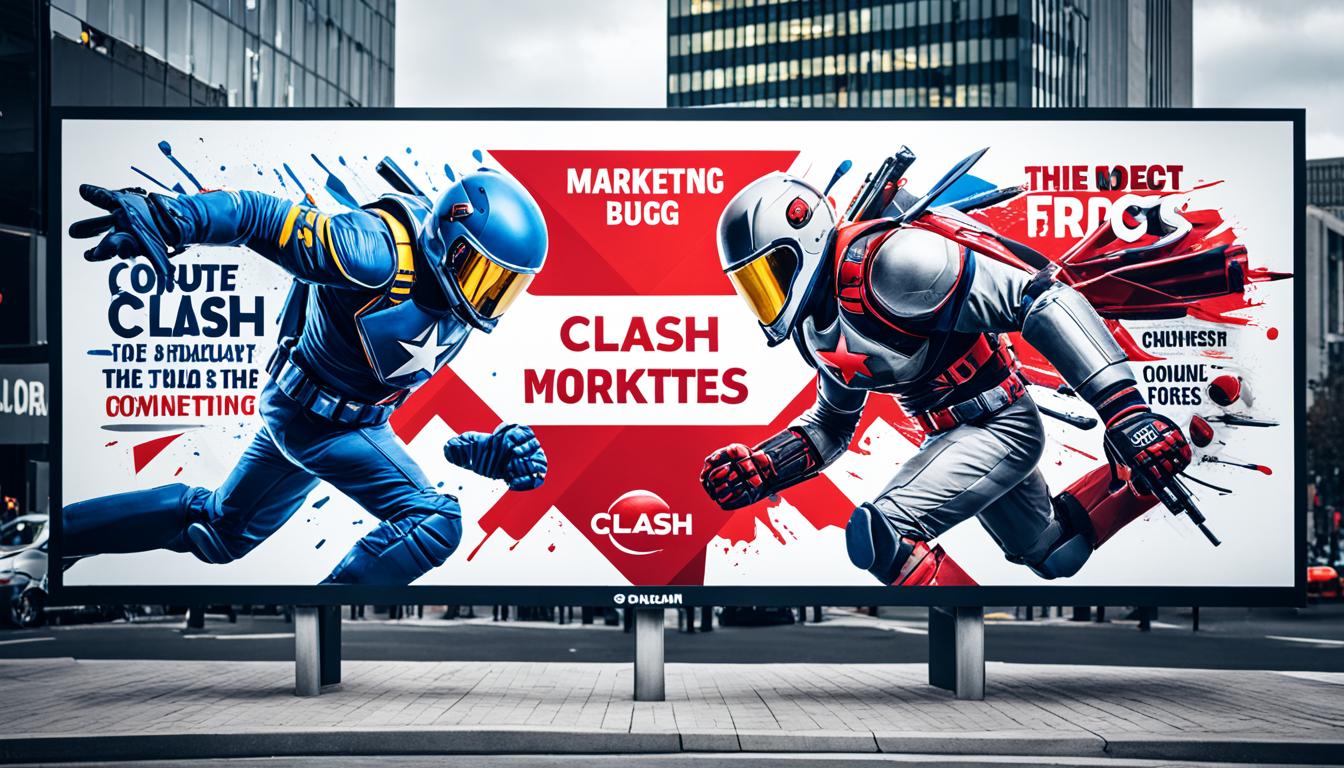Buzz marketing is a powerful viral marketing technique that focuses on maximizing word-of-mouth potential. It involves creating campaigns or events that generate excitement and get people talking about a brand or product. By leveraging unconventional and intriguing content, buzz marketing sparks conversations and promotes positive brand awareness. It is a cost-efficient way to reach a wider audience and generate organic publicity.
Key Takeaways:
- Buzz marketing is a viral marketing technique that relies on word-of-mouth promotion.
- It involves creating exciting campaigns or events that get people talking.
- Buzz marketing is cost-efficient and reaches a wide audience.
- It generates organic publicity and promotes positive brand awareness.
- By sparking conversations, buzz marketing can enhance brand visibility and customer engagement.
How Does Buzz Marketing Work?
Buzz marketing is a powerful technique that leverages social contagion and word-of-mouth promotion to create excitement and generate conversations about a brand or product. It takes advantage of the influence and reach of social media platforms and utilizes influencers to amplify the message and engage a larger audience.
Companies engage influencers strategically to share information about their products or campaigns, sparking interest and generating buzz. This helps create online conversations and build awareness around the brand. Buzz marketing strategies encompass various approaches to maximize impact and reach the target audience.
- Engaging influential bloggers: By partnering with influential bloggers who have a loyal following, companies can leverage their reach and credibility to generate buzz.
- Creating customer communities: Building dedicated customer communities allows companies to foster loyalty and create a buzz around their brand. These communities serve as platforms for customers to engage with each other and share experiences.
- Fostering real-time dialogue: Encouraging real-time dialogue with customers through social media platforms enables brands to engage directly with their audience and create a buzz. This can include responding to comments, addressing queries, and initiating conversations on trending topics.
It is important to differentiate buzz marketing from viral marketing, as they have distinct objectives and strategies. While viral marketing aims to create content that spreads rapidly and organically through online channels, buzz marketing focuses on generating conversations and excitement around a brand or product.
A successful buzz marketing campaign can significantly increase brand visibility, drive customer engagement, and ultimately contribute to business growth.
The Difference Between Buzz Marketing and Viral Marketing
While buzz marketing and viral marketing share the goal of generating brand awareness and engagement, they have different approaches and objectives:
| Buzz Marketing | Viral Marketing |
|---|---|
| Focuses on generating conversations and excitement around a brand or product. | Aims to create content that spreads rapidly and organically through online channels. |
| Uses influencers, social media platforms, and customer communities to amplify the message. | Relies on content being widely shared and circulated by users. |
| Engages with the target audience through real-time dialogue and personalized interactions. | Emphasizes the shareability and virality of the content. |
A thorough understanding of these differences is crucial for implementing effective marketing strategies and achieving desired outcomes.
Benefits of Buzz Marketing
Buzz marketing offers several benefits for businesses. It helps create a positive buzz around a brand or product, reaching beyond the usual target audience. By generating excitement and engaging conversations, buzz marketing generates free publicity and increases brand awareness, leading to potential sales growth. Moreover, it is a cost-effective form of advertising that relies on organic conversations and word-of-mouth promotion.
Buzz Marketing Tactics and Techniques
To achieve successful buzz marketing, companies employ various tactics and techniques. One effective strategy is leveraging controversial topics to generate interest and ignite conversations. By tackling subjects that spark debate, companies can attract attention and increase brand visibility. Additionally, using humor can capture audience attention and encourage social sharing, enhancing brand awareness. Creating remarkable content that stands out can also differentiate a brand from its competitors and stimulate interest. Lastly, relying on secrets or exclusivity can create a sense of anticipation and curiosity, generating buzz around a brand or product.
By implementing these buzz marketing tactics, companies can establish a strong online presence, attract new customers, and enhance their reputation. Through organic conversations and word-of-mouth promotion, buzz marketing creates a dynamic and engaging environment that fosters brand loyalty and long-lasting customer relationships.
Examples of Buzz Marketing
Many brands have successfully implemented buzz marketing campaigns to generate excitement and engage their target audience. Here are some notable examples of buzz marketing that have captured public attention:
-
ALS Ice Bucket Challenge
The ALS Ice Bucket Challenge became a global sensation in 2014. Participants would pour ice water over their heads and then nominate others to do the same, all in an effort to raise awareness and funds for amyotrophic lateral sclerosis (ALS) research. This campaign went viral on social media platforms and generated widespread buzz, with numerous celebrities and individuals participating in the challenge.
-
Dell’s On-Campus Campaign
Dell implemented an on-campus buzz marketing campaign targeting college students. The campaign involved brand ambassadors engaging with students, promoting Dell products, and creating meaningful conversations about the brand. By leveraging the enthusiasm of college students, Dell was able to increase brand awareness and generate buzz among its target audience.
-
Super Bowl Commercials
Super Bowl commercials are known for generating buzz and capturing viewers’ attention. Companies like Old Spice have used humorous and outrageous advertisements during the Super Bowl to create memorable experiences and generate conversation. These commercials often become highly anticipated and discussed long after the game.
-
Wendy’s Twitter Roasts
Wendy’s, a popular fast-food chain, gained attention and popularity through its witty and edgy Twitter posts. The brand took a unique approach by roasting other brands and engaging in playful banter on Twitter. This distinctive style attracted a large following and generated buzz around Wendy’s brand personality.
The above examples demonstrate the power of buzz marketing in creating memorable and shareable experiences. These campaigns successfully engaged their target audience, generated widespread conversations, and increased brand visibility. By capturing the attention and interest of the public, these brands were able to create a lasting impact through their buzz marketing efforts.
Different Types of Buzz Marketing
Buzz marketing utilizes various types of triggers to generate excitement and stimulate conversations about a brand or product. Understanding these different types of buzz marketing strategies enables companies to tailor their campaigns to resonate with their target audience and maximize their impact.
1. Taboo Subjects
Taboo subjects elicit controversy and ignite discussions. By leveraging taboo topics, brands can generate buzz and capture the attention of their audience. This type of buzz marketing strategy works by pushing boundaries and sparking conversations about social norms, cultural taboos, or controversial subjects.
2. Unusual Content
Unusual content stands out and captures people’s attention. It can be unconventional, unexpected, or thought-provoking, creating a memorable experience for the audience. By presenting content that breaks away from the norm, brands can generate excitement and intrigue, encouraging people to talk about their brand or product.
3. Remarkable Stories
Remarkable stories have the power to inspire and captivate. By sharing extraordinary narratives that touch people’s emotions, brands can create a strong connection with their audience. These stories evoke empathy and foster a sense of loyalty and engagement, making people eager to share their experiences with others.
4. Outrageous Elements
Outrageous elements shock and provoke a reaction. By incorporating elements that push the boundaries of what is expected or acceptable, brands can generate buzz and capture attention. Outrageous buzz marketing strategies aim to break through the clutter and create a lasting impression, influencing people to share and discuss the brand or product.
5. Hilarious Approaches
Hilarious approaches make people laugh and leave a lasting impact. By leveraging humor, brands can create a positive association and foster a sense of entertainment. Humorous buzz marketing strategies aim to evoke joy and amusement, encouraging people to share the content and spread the word.
6. Secrets
Secrets pique curiosity and create anticipation. By teasing the audience with the promise of exclusive information or hidden knowledge, brands can generate buzz and intrigue. Secrets have the power to capture people’s attention and make them eager to learn more, driving conversations and generating excitement.
By incorporating these different types of buzz marketing into their campaigns, brands can create memorable experiences that resonate with their target audience. Effective buzz marketing strategies leverage the power of these triggers to spark conversations, generate positive brand awareness, and drive customer engagement.
Why Buzz Marketing is Effective
Buzz marketing is a highly effective strategy that harnesses the power of social influence and word-of-mouth promotion. Unlike traditional advertising methods, consumers tend to trust recommendations from friends and influencers more. Buzz marketing campaigns capitalize on this trust by creating content that resonates with audiences and sparks conversations.
One of the key benefits of buzz marketing is that it generates a sense of excitement and exclusivity. When people experience something unique or remarkable, they become eager to share their experiences and recommendations with others. This organic sharing creates a ripple effect, reaching a wider audience and generating authentic engagement.
By leveraging the power of social contagion, buzz marketing campaigns can elevate brand visibility and drive customer loyalty. As individuals share their positive experiences and recommendations, it creates a positive buzz around the brand, leading to increased brand awareness.
Furthermore, buzz marketing is an effective and cost-efficient advertising method. Instead of relying solely on paid advertisements, buzz marketing generates organic conversations and word-of-mouth promotion. This not only reduces advertising costs but also makes the campaign more relatable and trustworthy for the target audience.
Overall, the effectiveness of buzz marketing lies in its ability to tap into the power of social influence, generate excitement, and create authentic engagement with a wide audience. By implementing buzz marketing strategies, companies can effectively elevate their brand visibility, drive customer loyalty, and achieve long-term success.
How to Create a Buzz Marketing Campaign
Creating a successful buzz marketing campaign requires careful planning and execution. By following key steps and strategies, companies can effectively generate buzz and create meaningful connections with their target audience.
1. Understand Your Target Audience
Start by studying your target audience to gain insights into their preferences, needs, and interests. Understanding your audience’s demographics, behaviors, and online habits will help you tailor your buzz marketing campaign to resonate with them.
2. Create Teasers to Generate Anticipation
Teasers are a great way to build anticipation and generate buzz before launching your campaign. Create captivating and intriguing teasers that hint at something exciting to come. This will pique curiosity and get people talking, eagerly awaiting the big reveal.
3. Develop a Branded Hashtag
Creating a branded hashtag is essential for tracking and engaging with your audience. Make sure it’s unique, memorable, and reflective of your campaign. Encourage users to include the hashtag in their social media posts to amplify the buzz and increase brand visibility.
4. Deliver Valuable Content
Focus on delivering valuable content that resonates with your target audience. Whether it’s informative, entertaining, or inspiring, make sure your content adds value and sparks conversations. This will encourage people to share and engage with your campaign.
5. Incorporate Video Marketing
Video marketing is a powerful tool for creating engagement and driving buzz. Consider incorporating videos into your buzz marketing campaign to capture attention and convey your message effectively. Whether it’s a teaser, a behind-the-scenes look, or user-generated content, videos can enhance the overall experience and generate more buzz.
6. Find the Right Influencers
Identify influencers who align with your brand and campaign goals. Collaborating with influencers can help amplify your message and reach a wider audience. Make sure to choose influencers whose values and audience align with your target market.
7. Monitor and Analyze Results
Monitor and analyze the results of your buzz marketing campaign to gain insights and make data-driven improvements. Track metrics such as engagement, reach, and brand sentiment to understand the impact of your campaign and identify areas for optimization.
By following these steps, you can create a successful buzz marketing campaign that generates excitement, sparks conversations, and drives brand awareness. Embrace creativity, understand your audience, and deliver valuable content to maximize the impact of your campaign.
Benefits of Buzz Marketing
Buzz marketing campaigns offer numerous benefits for businesses, helping them achieve increased brand awareness, build a robust online presence, generate organic traffic, and foster high levels of engagement. Unlike traditional paid advertising, buzz marketing relies on the power of word-of-mouth promotion, effectively leveraging conversations and social influence. Let’s explore the key benefits that buzz marketing can bring to businesses:
1. Increased Brand Awareness
Buzz marketing has the potential to catapult brand visibility beyond the usual target market. By creating campaigns or events that generate excitement and intrigue, businesses can create a positive buzz and reach a wider audience. When people engage in conversations about a brand or product, it increases brand recognition and establishes a memorable presence in the minds of consumers.
2. Strong Online Presence
With the digital age, an online presence is crucial for any business. Buzz marketing campaigns provide an opportunity to create meaningful connections in the online space. As people share and talk about the campaign, it generates valuable user-generated content, social media mentions, and online discussions. These interactions contribute significantly to building a strong online presence.
3. Organic Traffic Generation
Traditional advertising often requires substantial investments to drive traffic to websites or physical locations. On the other hand, buzz marketing relies on the power of organic conversations to generate traffic. By creating engaging and remarkable content, businesses can attract potential customers who are genuinely interested in their offerings. This organic traffic is often more valuable and likely to convert into sales.
4. High Levels of Engagement
Buzz marketing excels at attracting attention and engaging consumers. When a campaign sparks conversations and generates excitement, people are more likely to actively participate and engage with the brand. This level of engagement can range from sharing content, commenting on social media posts, attending events, or actively discussing the brand with others. Such engagement strengthens the relationship between the brand and its audience and fosters long-lasting customer relationships.
5. Cost-Effective Advertising
Compared to traditional forms of advertising, buzz marketing is a cost-effective strategy. It relies on organic word-of-mouth promotion, which significantly reduces the need for paid advertisements. By creating remarkable and shareable content, businesses can leverage the power of conversations and generate widespread exposure without breaking the bank.
These are just a few examples of the benefits that buzz marketing can bring to businesses. By tapping into the power of conversations, social influence, and remarkable content, brands can create genuine excitement, establish a strong brand presence, and foster lasting connections with their target audience. The examples provided in the previous section further illustrate the effectiveness of buzz marketing in generating buzz, capturing attention, and creating memorable experiences.
Examples of Buzz Marketing
Successful buzz marketing campaigns have been implemented by various brands across different industries. These examples showcase how buzz marketing can generate widespread interest and engagement, leading to increased brand visibility and positive consumer perception.
Apple’s “One more thing” Strategy
During product launches, Apple’s “One more thing” strategy creates anticipation and excitement among consumers. By unveiling a surprise announcement or product addition towards the end of the event, Apple generates widespread conversations and positive brand awareness. This approach not only keeps the audience engaged but also builds anticipation for future releases, fueling the buzz around Apple’s products.
Dell’s Laptop Campaign for School Children
Dell’s campaign to provide laptops for school children has generated significant attention and participation from the public and other organizations. This initiative not only showcases Dell’s commitment to social impact but also creates a buzz around the brand’s commitment to education and technology. By aligning with a cause that resonates with their target audience, Dell effectively generates positive brand perception and engages consumers in meaningful conversations.
Conclusion
Buzz marketing is a powerful viral marketing strategy that creates excitement and sparks conversations about a brand or product. By leveraging unconventional and intriguing content, utilizing social media platforms and influencers, and generating organic word-of-mouth promotion, buzz marketing can effectively increase brand awareness, reach a wider audience, and drive brand growth.
With its cost-effective nature and ability to tap into the power of social influence, buzz marketing offers several benefits for businesses. It not only generates free publicity but also creates a sense of exclusivity and authenticity that resonates with consumers. By understanding the different types of buzz marketing and implementing effective strategies, companies can successfully generate buzz, engage their target audience, and establish a strong online presence.
Overall, buzz marketing is a valuable tool in today’s digital landscape, allowing brands to create memorable and shareable experiences that capture the attention of consumers. By embracing the power of conversations and social contagion, businesses can leverage the full potential of buzz marketing to elevate their brand visibility, drive customer loyalty, and achieve long-term success.



